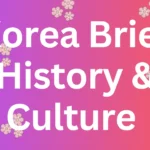Welcome to kk world. Korean culture lover do you want to know about the world religion history? Let’s learn about the Korean religion history. Nestled within the vibrant heart of East Asia, Korea has long been a cradle of rich spiritual heritage, where the threads of various religious traditions weave a complex tapestry reflecting its historical depth and cultural diversity. This article delves into the profound religious landscape of Korea, exploring how shamanism, Buddhism, Confucianism, Christianity, and other beliefs have shaped the nation’s identity.
Traversing the Dynamic Religious History of Korea
Shamanism – The Ancient Soul of Korean Spirituality
Before the advent of written history, the indigenous belief system of shamanism was deeply rooted in the Korean peninsula. It revolves around the worship of natural elements and ancestral spirits, with shamans (mudang) acting as intercessors. Key to Korean shamanism is the robust practice of kut rituals—dynamic ceremonies filled with music, dance, and incantations aimed at pleasing the spirits or seeking their guidance. The enduring presence of shamanistic elements in modern Korea attests to its resilient influence on the country’s cultural psyche.
Buddhism – A Journey from Enlightenment to Royal Patronage
Buddhism sailed from India through China to Korea in the 4th century CE during the Three Kingdoms period. Flourishing under royal patronage, particularly during the Unified Silla (668-935 CE) and Goryeo (918-1392 CE) dynasties, Buddhist monasteries became powerhouses of education, art, and literature. The religion’s emphasis on meditation and monastic life appealed to many Koreans seeking spiritual depth and moral direction. Buddhist temples like Bulguksa and the Seokguram Grotto—architectural marvels adorned with exquisite statuary—stand today as UNESCO World Heritage sites, testimonies to Buddhism’s golden age in Korea.
Buddhism Impact
Koguryŏ, Paekche, and Silla accepted Buddhism formally in 372–384, 384–584, and 529, respectively. It functioned as a political and cultural tool. During the reign of King Sosurim, the Chinese missionary monk Sundo came to Koguryŏ and forged a tight relationship between the monarchs and Buddhist clergy. Buddhist temples were built, and there was a great deal of evangelizing done by Korean monks who traveled as missionaries to China and Japan thanks to state interest and royal support.
Through Eastern Jin, the Serindian monk Mŭlŭnanda brought Buddhism to Paekche. Buddhism was first founded as a royal religion, and part of its appeal in Korea was that it could mimic important aspects of shamanism, including healing. The role and status of the mudang were replaced by Buddhism throughout the Silla and Koryŏ regimes, leaving their social and political status unclear.
Not only are mudangs mentioned in the records of Koryŏ, but there are also references to taxation and persecution during musk celebrations. The majority of people continued to support the mudang’s effectiveness despite this, but their beliefs were suppressed as an official and elite worldview gained traction.
Shamanism and State Formation
The Neolithic people that inhabited the Korean peninsula around 4000 BCE were hunters, fishers, and gatherers. Around the third millennium BCE, they turned to agriculture, with clans dividing into discrete geographical areas. Political stratification and metallurgical technology were introduced during the Bronze Age, while improved weaponry was delivered by the Tungus. All along the peninsula and in modern-day eastern and southern Manchuria, states have formed; the strongest of them was the ancient Chosŏn, a tribal confederation in the northwest near China.
Ancestral worship and divine kingship were added to the animistic belief system of shamanism by shamans, men with ceremonial and political authority. As hereditary authority evolved, its religious component was preserved, strengthening the Korean Peninsula’s political structure. All natural objects, including mountains, rivers, trees, and people, are said to be moved by a soul or spirit, according to shamanic doctrine. Through ceremonial dancing and singing, heavenly princes may govern these spirits through ceremonies.
During agricultural seasons, ancient Korean tribal rituals featured offerings to heaven on mountaintops or in holy woods. Worshiping the sun and other natural objects led to the belief in heaven and a ruler (humanism). The concept of holy kingship is established by these foundation stories, where Tan’gun plays a prominent role in the history of ancient Chosŏn. Early Korean history’s link between shamanism and royalty and how it developed into national identity has been noteworthy.
Buddhism replaced governmental protection by introducing essential musk ceremonial activities. At the state-sponsored Buddhist holiday, P’algwanhoe, laypeople were urged to follow eight austere precepts and offer prayers for the government. The Koryŏ era’s yearly festivals honored spirits of all kinds and rejoiced in joy via feasting, dancing, and singing. The official dress code had detrimental effects on the musk, which made fortune-telling and magic more common in the province of peasants.
Musok finally lost out to Buddhism because of its sophisticated religious system and governmental backing. Buddhism also included funeral customs, such as the Manghon-il festival, into its worldview. Two sūtras that recount the Buddha’s creation of the ghost festival and highlight monks’ function as go-betweens between ancestors and descendants have been added to the canon of Chinese Buddhism.
Confucianism – The Socio-Political Blueprint
The rise of the Joseon Dynasty (1392-1910 CE) heralded a seismic shift towards Confucian ideals. Less a religion and more a philosophical system, Confucianism became the official ideology dictating governance, societal norms, education, family relationships, and ethical conduct. The state examination system for selecting officials (gwageo) was one such Confucian practice pivotal in shaping Korea’s administrative and social structure. Although its strict hierarchy faced criticism over time, Confucian values like filial piety remain deeply ingrained in Korean culture.
Christianity – The Western Wave
Christianity entered Korea through Catholic missionaries in the late 18th century but gained significant traction only in the 19th century with Protestant missions. Despite initial persecution, Christian ideals resonated with many Koreans’ desires for modernity and reform. Today, Christianity is prevalent in South Korea, with megachurches like Yoido Full Gospel Church exemplifying its rapid growth. These churches not only cater to spiritual needs but also actively engage in social issues, contributing to humanitarian efforts both domestically and internationally.
Christianity Transmission
Christianity entered Korea as a result of its exposure to the West in the 17th century. A small amount of Catholicism was brought to Korea by Jesuit missions in China during the 17th century, but the Korean court suppressed Catholicism out of fear of the name and the dispute surrounding the introduction of Chinese rituals. About fifteen thousand Catholics lived in the country in 1857, but the Great Persecutions, which took place between 1866 and 1871, practically halved that number. Protestant missionary work in Korea started at the same time when Catholic martyrdom was occurring.
In Korea, Protestant missionaries founded the country’s first modern educational institutions, which included over 300 Christian-founded schools and 40 universities. The first generation of Korean pastors was ordained around the beginning of the 20th century when seminaries were established to train local clergy. Overall, Christianity became more respectable due to Protestantism’s extraordinary success, and by the turn of the century, Catholicism had also improved.
New Religious Movements – Innovation in Faith
Korea has not been immune to the global trend of emerging new religious movements. In response to contemporary challenges and quests for identity, religions like Cheondoism—a syncretic faith combining elements of shamanism, Buddhism, and Confucianism—and Won Buddhism—a reformed strain focusing on practical application—have surfaced. These innovative faiths embody a unique blend of traditional spiritual motifs with modern ethos.
Syncretism – The Blending Boundaries
One cannot overlook the dynamic syncretism characterizing Korean religious life. Rituals often intertwine elements from different faiths; for instance, it is not uncommon for a Buddhist funeral rite to incorporate Confucian mourning customs or for Christian families to honor their ancestors in ways echoing shamanistic traditions.
The Modern Era
The next nations to tear down the walls of the “hermit kingdom” were the United States, the United Kingdom, Japan, and Germany. Their push for trade treaties signaled the start of Korea’s modern era in the late nineteenth century. Between 1910 and 1945, Korea lost its freedom to the Japanese because of forced globalization that revealed the basic faults in the society, particularly those of its leaders. Even after being liberated from colonial rule, Korea’s dependence on foreign powers led to its division into the north and south, with support from the US and the Soviet Union, respectively. Commencing on June 1st, the civil war resulted in a firmly established north-south separation three years later.
Conclusion
The religious history of Korea is one marked by adaptation and resilience. From shamanistic rituals beneath ancient skies to solemn prayers in high-tech megachurches; from austere Confucian academies to serene Buddhist temples—the diversity is staggering yet harmonious. As Koreans navigate their path forward in a rapidly changing world, their spiritual traditions continue to offer solace, guidance, and a sense of belonging rooted in millennia-old legacies.
Korea’s journey through various phases of religious influence has not only contributed significantly to its national identity but also positioned it uniquely at the intersection of tradition and modernity—an eloquent testament to humanity’s timeless quest for meaning and connection.


